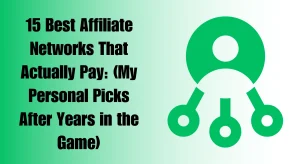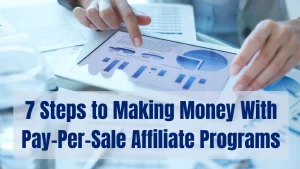How to Apply and Get Approved by Affiliate Programs: A Step-by-Step Guide

Affiliate marketing is one of the easiest ways to start making money online. You don’t need to create a product, handle customer service, or worry about shipping. Your job is simple: recommend products or services, and when someone buys through your link, you earn a commission. That’s why so many people jump into it.
But getting approved for affiliate programs isn’t always as easy as signing up. When I first started, I assumed it was just a quick form and a done deal. I applied to a few programs, sat back, and waited for that welcome email.
Instead, I got rejection after rejection. Some programs never responded at all. That’s when I realized there’s more to it than just filling out an application.
For example, here are some of the rejection emails I received from several brands:
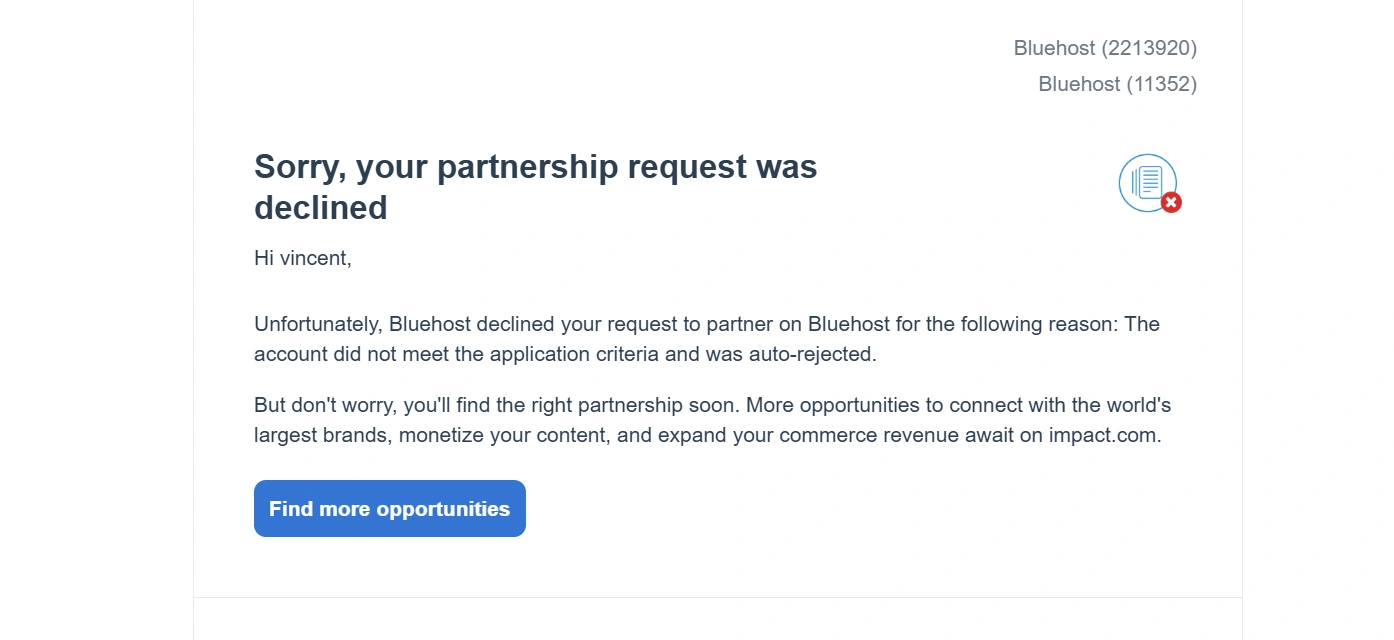
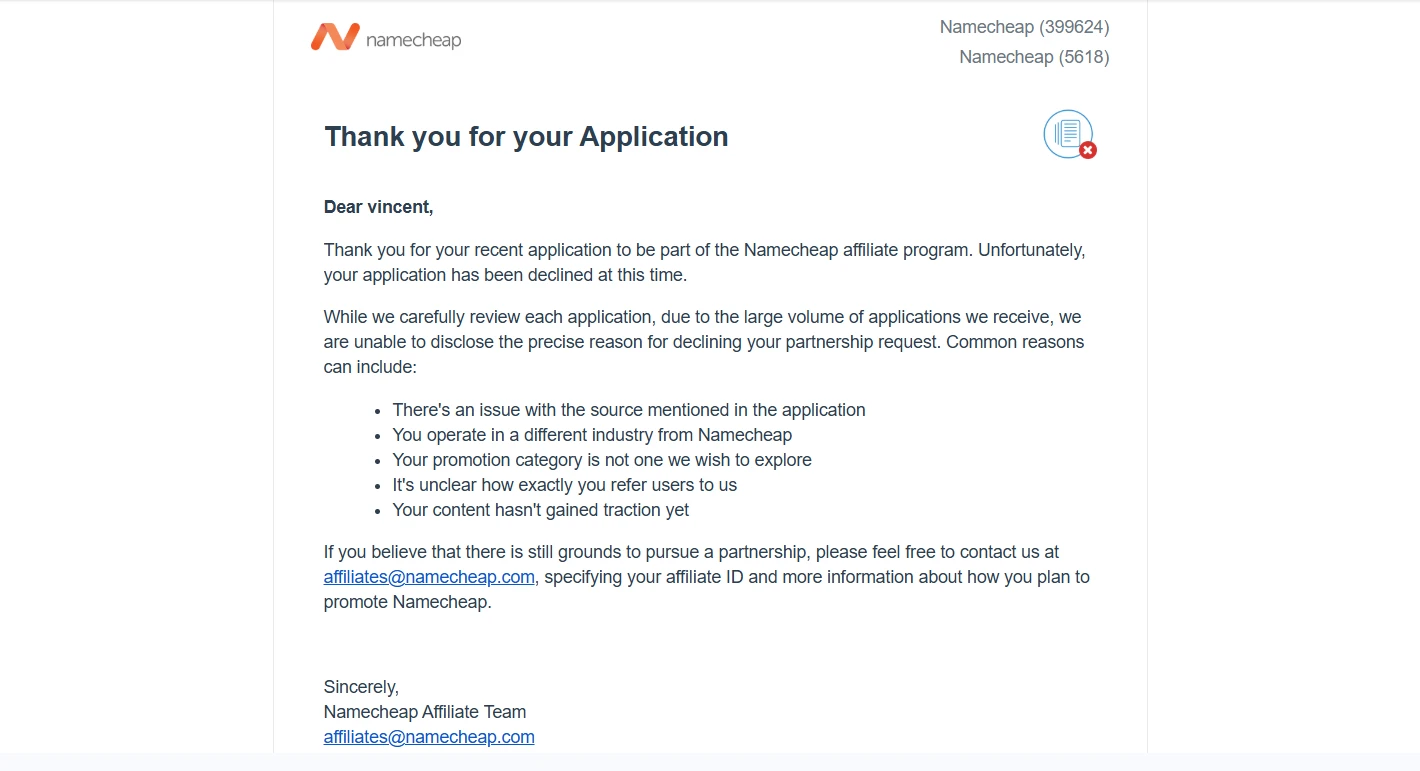
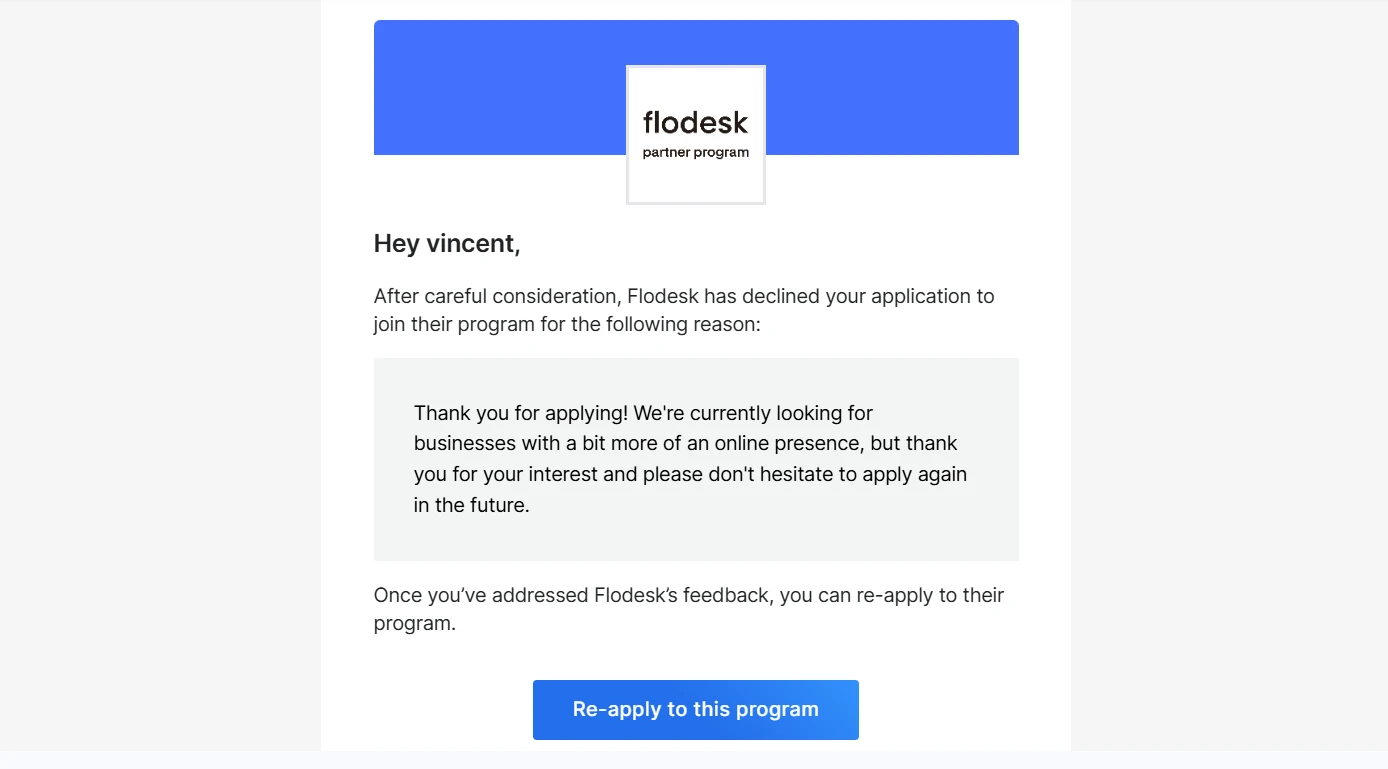
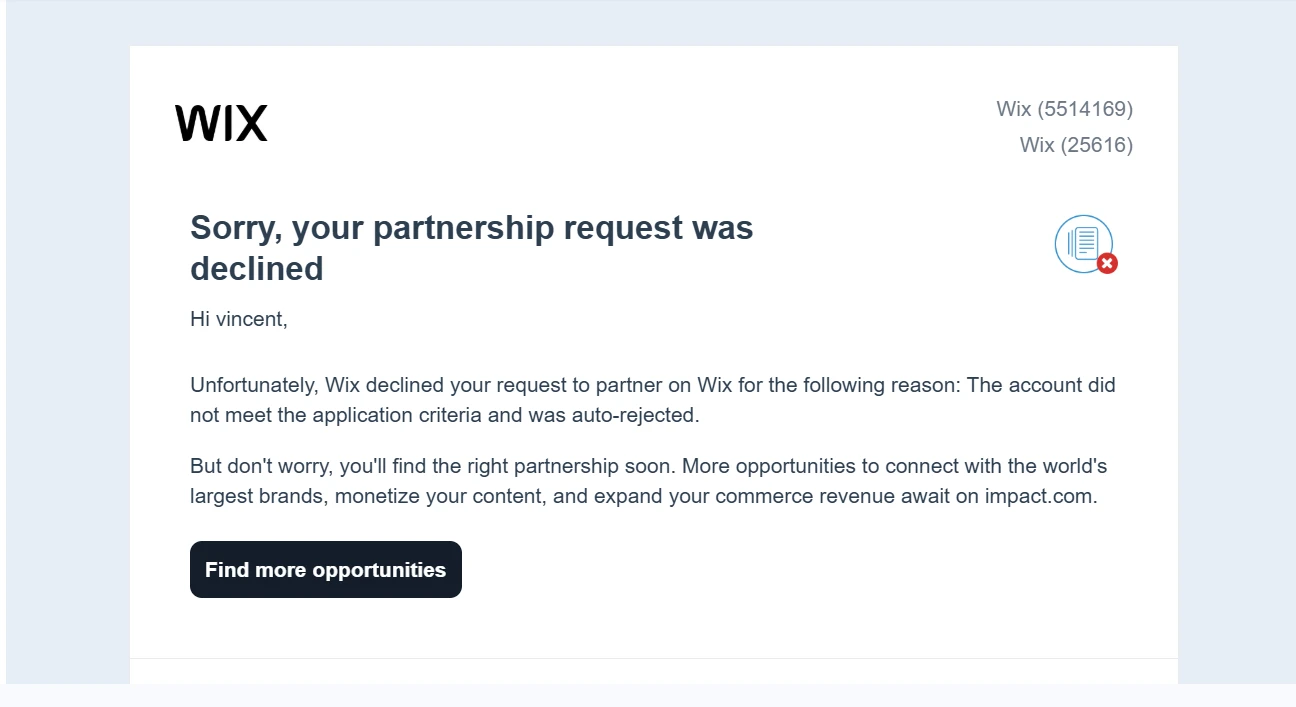
Companies want to know you can actually send traffic and make sales. If you apply without a solid plan, they’ll turn you down. The good thing about it is that you don’t need a massive audience or years of experience to get accepted. You just need to apply the right way.
That’s what this guide is about: helping you apply and get approved by affiliate programs, choose the best ones, set yourself up for approval, and avoid the mistakes that got me rejected early on.
Follow these steps, and you’ll have a much better shot at getting in and making money. Let’s get started.
Key Takeaways
- Affiliate programs don’t accept everyone – You need to show value before getting approved.
- I got rejected at first – Applying without a plan leads to rejection.
- Choose the right programs – Some are beginner-friendly, while others have strict requirements.
- Have an online presence – A website, blog, or active social media boosts approval chances.
- Write a strong application – Show how you’ll promote their products.
- Traffic matters – Programs prefer affiliates who can drive sales, even without huge numbers.
- Reapply if rejected – Fix weak spots and try again. Many people get in on the second attempt.
1. Understanding Affiliate Programs
Affiliate marketing works best when you understand how programs track sales, how they pay commissions, and which ones fit your strategy.
Some programs pay only for completed sales, while others reward clicks or leads. Choosing the right type can make a big difference in your earnings. Let’s break it down.
What Is an Affiliate Program?
An affiliate program is a partnership between a company and an individual (the affiliate) who promotes its products or services. When someone buys through the affiliate’s unique link, the company pays a commission.
It’s a win-win model: the company gets more sales, and the affiliate earns money without creating their own product.
Affiliate programs exist across almost every industry, from tech and fashion to finance and online courses. Some pay a few dollars per sale, while others offer high commissions, especially for software and subscription-based services.
How Affiliate Programs Work
Here’s a simple breakdown of how affiliate programs function:
- Sign Up – You apply to join a company’s affiliate program. Some approve instantly, while others review your application.
- Get Your Unique Link – Once accepted, you receive a special tracking link to share with your audience.
- Promote Products or Services – You use your link in blog posts, social media, YouTube videos, emails, or ads.
- Drive Traffic – People click your link and visit the company’s website.
- Earn Commissions – If they make a purchase (or complete another required action), you get paid.
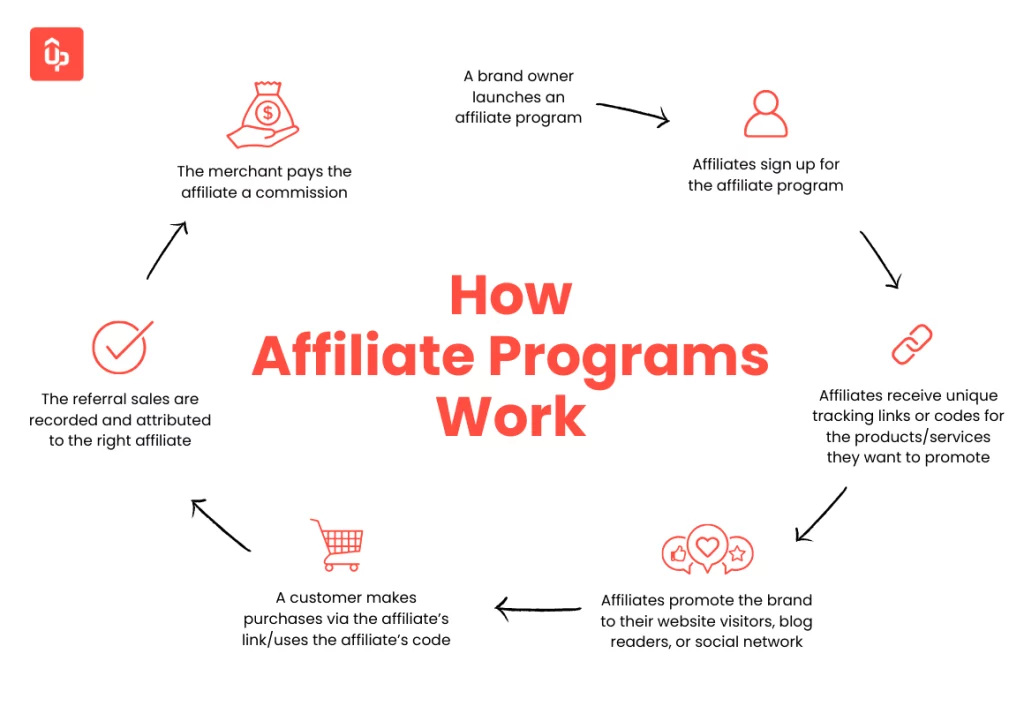
Most programs track referrals using cookies, which store information about visitors for a set period (like 7, 30, or even 90 days). If someone clicks your link but buys later within the cookie duration, you still earn a commission.
Types of Affiliate Programs
Not all affiliate programs work the same way. They differ in how they pay affiliates:
- CPS (Cost Per Sale) – The most common model. You earn a commission only when someone makes a purchase through your link. Examples: Amazon Associates, Shopify, and Bluehost.
- CPC (Cost Per Click) – You get paid based on how many people click your affiliate link, regardless of purchases. Less common but used in display ads and certain networks.
- CPA (Cost Per Action) – You earn money when a visitor completes a specific action, like signing up for a free trial or submitting an email. Examples: credit card offers, software trials, and lead-generation programs.
- Recurring Commissions – Instead of a one-time payment, you earn ongoing commissions as long as the customer stays subscribed. Common in SaaS (Software as a Service) programs like GetResponse, ClickFunnels, and SEMrush.
- Two-Tier Programs – You earn commissions not just from your own referrals but also from affiliates you recruit. Some programs offer this as a way to build a secondary income stream.
Each type has its pros and cons. CPS programs usually have high conversion rates but lower payouts, while CPA and recurring commissions can be more lucrative over time. Understanding these models helps you choose the best programs for your strategy.
2. Choosing the Right Affiliate Program
Picking the right affiliate program can make or break your success. If you promote low-paying or unreliable programs, you’ll waste time and effort. The key is to find programs that fit your niche, pay well, and have a good reputation. Here’s how to choose wisely.
Researching and Selecting Programs That Match Your Niche
Start by looking for affiliate programs related to your content or audience. Promoting random products won’t work—you need programs that align with what your audience already cares about.
- If you run a tech blog, look for software, gadgets, or hosting affiliate programs.
- If you focus on fitness, consider supplements, workout gear, or online training programs.
- If you teach personal finance, explore credit card, banking, or investment platforms.
A good affiliate program should offer products people actually want. Check reviews, see if there’s demand, and make sure it’s something you’d recommend yourself. If you wouldn’t use it, don’t promote it.
Checking Commission Structures and Payment Terms
Different programs pay in different ways. Some offer small, one-time commissions, while others provide recurring payments. Pay attention to:
- Commission Rates – Some pay as little as 3%, while others offer 30% or more per sale. Higher commissions can mean better earnings.
- Payout Thresholds – Some programs won’t pay you until you earn a minimum amount, like $50 or $100. If the threshold is too high, it could take months to get paid.
- Payment Methods – Check how they pay (PayPal, bank transfer, crypto, etc.) and make sure it works for you.
- Cookie Duration – Some programs track referrals for 24 hours, while others give you 30–90 days. A longer cookie window increases your chances of earning commissions.
Related Topic: Understanding the Affiliate Commission Structure: What It Is and How It Works
Evaluating Brand Reputation and Support
A high-paying program means nothing if the company has a bad reputation. If a brand has poor customer service or refuses to pay affiliates, you’ll regret signing up.
- Read Affiliate Reviews – Search for feedback from other affiliates to see if they actually get paid on time.
- Test the Product or Service – If possible, try it yourself. Promoting something you believe in makes your recommendations more convincing.
- Check Affiliate Support – A good program offers marketing materials, dedicated support, and clear tracking. If a company ignores affiliates, it’s a red flag.
Choosing the right affiliate program takes time, but it’s worth it. The best programs align with your niche, pay well, and treat affiliates fairly. Take the time to research before applying—it’ll save you headaches later.
Recommended Reading: How to Choose the Best Affiliate Programs for More Earnings and Long-Term Growth
3. Preparing for the Application
Affiliate programs don’t just accept anyone. Companies want affiliates who can drive traffic and make sales. If you apply without a solid foundation, you’ll likely get rejected. But remember, as I said above, you don’t need a massive audience or years of experience, just a few key things in place.
Building a Professional Website or Blog
A website makes you look serious. It gives companies confidence that you can actually promote their products. Many programs won’t approve you if you apply without one.
- Pick a niche – Your site should focus on a specific topic. A random blog covering everything won’t help. Stick to something you know and can create content around.
- Use a clean design – A simple, professional-looking website works best. Avoid clutter and unnecessary distractions.
- Have important pages – Add an About page (who you are), a Contact page (how to reach you), and a Privacy Policy (for legal compliance). Some programs require these.
If you don’t have a website yet, build one before applying. You don’t need anything fancy, but you do need a solid foundation.
Creating Quality Content and Having Some Traffic
Affiliate managers don’t expect you to have thousands of visitors, but they do want to see content that shows you know what you’re doing. Before applying, publish at least a few well-written blog posts or videos related to your niche.
- Write helpful content – Reviews, how-to guides, and comparison posts work best. Show that you can actually drive interest in products.
- Be consistent – A website with just one or two posts looks inactive. Aim for at least five to ten solid articles before applying.
- Get some traffic – Even a small audience helps. Share your content on social media or answer questions in forums to start getting visitors.
If your site has no content and no traffic, your chances of approval drop. Put in a little effort upfront, and it’ll pay off.
Establishing an Audience (Email List, Social Media Presence)
Companies prefer affiliates with an existing audience. You don’t need a big following, but showing some engagement makes a difference.
- Build an email list – Even a small list of 100+ subscribers shows you have a way to reach potential buyers. Offer a free guide or resource to get people to sign up.
- Grow your social media – If you don’t have a website yet, a strong social media presence can help. Active Instagram, TikTok, YouTube, or Twitter accounts with real engagement can boost your chances.
- Be active in your niche – Join Facebook groups, participate in discussions, and engage with potential customers. It shows programs that you have influence.
Affiliate programs want to partner with people who can drive results. The more effort you put into your website, content, and audience before applying, the better your chances of approval. Set yourself up for success first, then start applying.
4. Applying for an Affiliate Program
Submitting an affiliate application takes more than just filling in blanks. Programs look for partners who can drive real results. A rushed or vague application can lead to rejection. To boost your chances, approach it strategically. Here’s how to do it.
Finding the Application Page
Most companies with affiliate programs have a dedicated page where you can sign up. You’ll usually find it:
- On their website – Look for links like Affiliate Program, Partners, or Earn with Us in the footer.
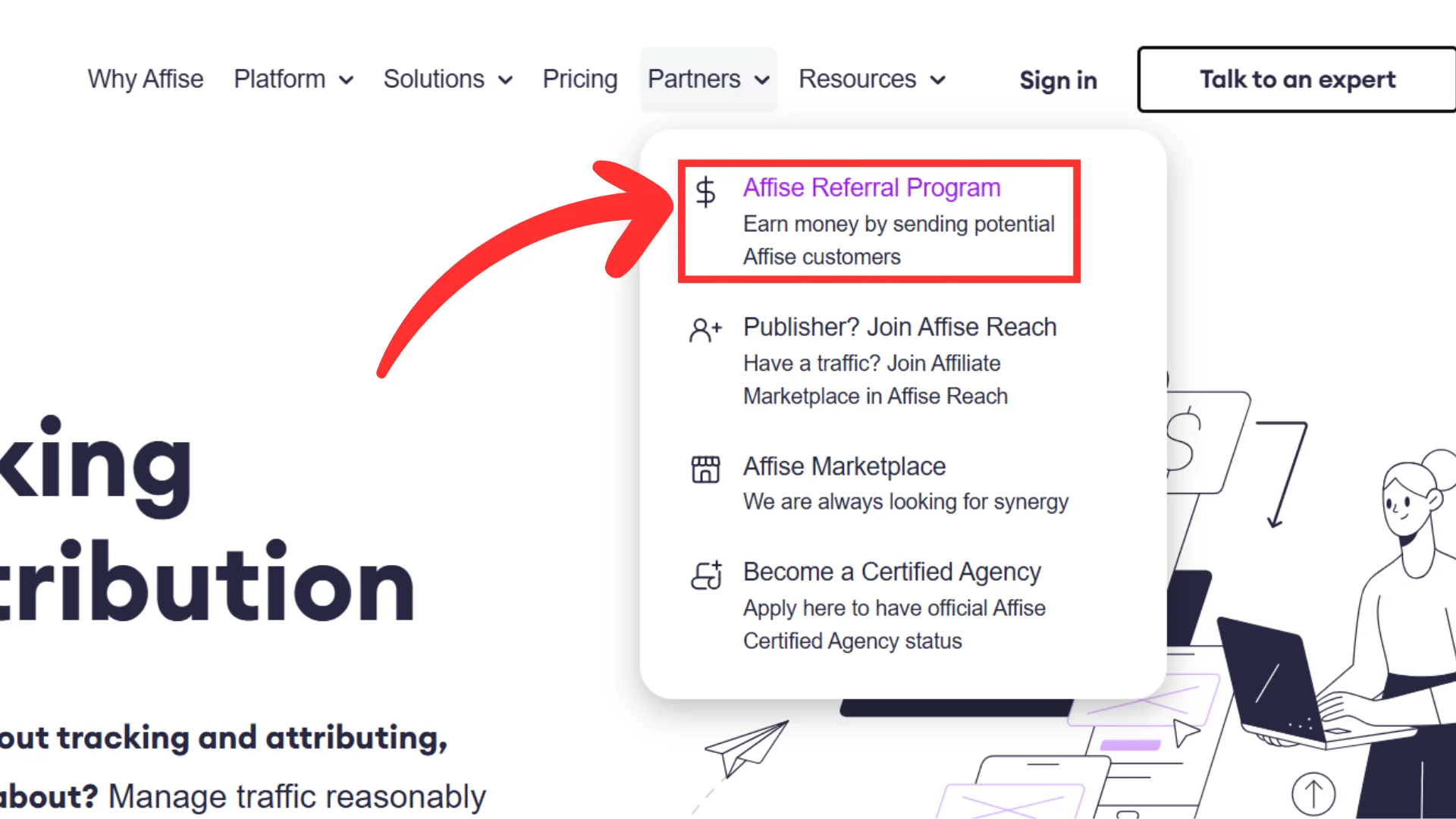
- Through affiliate networks – Some brands don’t run their own programs. Instead, they use networks like ShareASale, CJ Affiliate, or Impact.
- With a quick search – If you can’t find it, just Google “[Company Name] affiliate program.” That usually does the trick.
Before you apply, read the program’s terms. Some have restrictions based on location, traffic sources, or content type. Make sure you actually qualify before submitting your application.
Providing Accurate and Complete Information
Affiliate programs want to know who they’re partnering with. If your application looks rushed, incomplete, or vague, it’s an easy rejection.
- Use your real name and contact details – Some programs manually review applications. If your info seems fake, they’ll ignore it.
- Provide a professional website or social media profile – If you have a blog, YouTube channel, or active social media, include those links. It helps show credibility.
- Describe your marketing strategy – Some applications ask how you plan to promote their products. Don’t leave this blank—give a clear, confident answer.
If a company sees you as someone who just spams links or has no real audience, they won’t approve you. Be detailed and professional.
Writing a Strong Application (How to Position Yourself as a Good Partner)
This is where most people mess up. They treat the application like a boring form instead of an opportunity to sell themselves. If the program asks why you want to join, don’t just say, “I want to make money.” That won’t impress anyone.
Instead, show them why you’d be a great affiliate:
- Highlight your audience – Mention your blog, social media following, or email list. Even if it’s small, emphasize engagement.
- Explain how you’ll promote their product – Will you write reviews? Create tutorials? Make videos? Be specific.
- Show you understand their brand – If you’ve used their product before, mention it. Companies love affiliates who actually believe in what they’re promoting.
Here’s an example of a strong response:
“I run a tech blog where I review and compare different software tools. My audience includes freelancers and small business owners looking for the best solutions to grow their business. I plan to promote your product by writing in-depth reviews, creating tutorial videos, and sharing it with my email list of 1,000+ subscribers.”
That sounds way better than just saying, “I want to promote your product and earn commissions.”
Finally, applying for an affiliate program means more than filling out a form. You need to convince the company that you’re worth approving.
Take a few extra minutes to write a strong application, provide complete details, and show that you have a real plan. That will improve your chances of getting approved.
5. Increasing Your Chances of Approval
Getting approved for an affiliate program isn’t just about applying. You need to show the company that you can actually promote their products. Many beginners get rejected because they apply without a strategy. Here’s how to improve your chances.
Have a Clear Marketing Strategy
Affiliate programs don’t want random applicants. They want people who know how to sell. Before you apply, be ready to explain how you plan to promote their products.
- Content Creation – Will you write blog posts, record YouTube videos, or post on social media? Be specific.
- Traffic Sources – Are you getting visitors from search engines, social media, email lists, or paid ads? Show that you have a plan.
- Promotion Methods – Will you do product reviews, tutorials, comparisons, or case studies? Programs prefer affiliates who create useful content.
If an application asks how you’ll promote the product, don’t give a generic answer. A weak response like “I’ll share it on social media” won’t make it. Instead, say something like:
“I run a blog about productivity tools. I plan to write in-depth reviews, create tutorials, and compare different software options to help readers choose the best one.”
That shows you understand marketing and can drive sales.
Show That You Have an Engaged Audience
Even if your audience is small, engagement matters more than numbers. A program would rather approve someone with 1,000 loyal followers than 10,000 who don’t care.
- If you have a blog: Show proof of traffic. Even a few hundred monthly visitors can help.
- If you use social media: Mention follower engagement, not just numbers. Do people comment, like, and share your posts?
- If you have an email list: Share how often you send emails and what your open rates are. Programs love affiliates who use email marketing.
You don’t need massive traffic, but you must show that your audience listens to you.
Avoid Common Mistakes That Lead to Rejection
Many beginners get rejected because they make simple mistakes. Here’s what to avoid:
- Applying too soon – If you have no content, traffic, or audience, wait until you do. Programs don’t approve empty websites.
- Giving vague answers – When asked how you’ll promote their products, don’t be generic. Be detailed.
- Using fake information – Never lie about traffic, audience size, or marketing plans. Programs can check, and dishonesty gets you banned.
- Choosing the wrong program – Some programs require specific qualifications. Read their terms before applying.
Affiliate programs want real marketers, not random applicants. If you can show that you have a strategy, an engaged audience, and a real plan to promote their products, you’ll have a much better chance of getting approved.
6. What to Do If You Get Rejected
Getting rejected by an affiliate program is frustrating, but it’s not the end of the road. When I started affiliate marketing, I faced several rejections—but I didn’t give up.
For example, Bluehost rejected me nearly five times before finally approving my application. At first, I had no idea why. My site was live, and I had content, but it wasn’t enough.
This was the 5th rejection email they sent me:
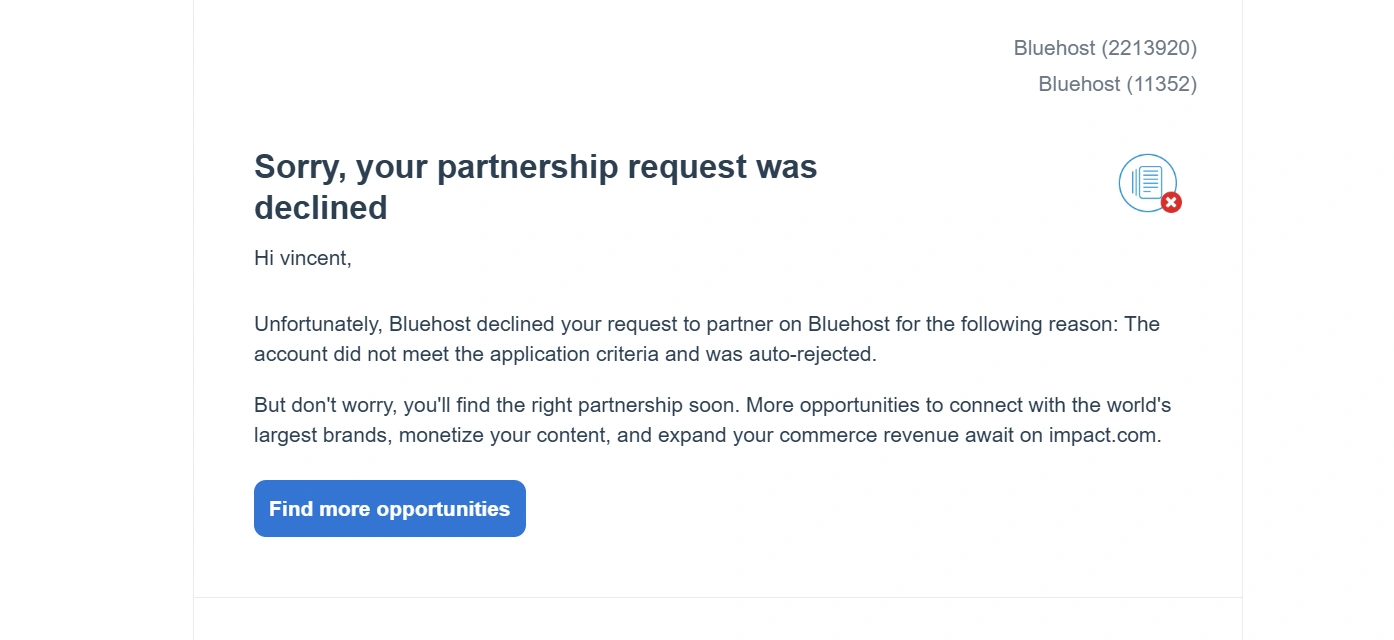
Instead of quitting, I dug deeper and realized they wanted a well-structured website with valuable posts and a clear audience. So, I made the necessary changes. If you get rejected, here’s how to handle it.
Understand Why You Got Rejected
Affiliate programs rarely reject people without a reason. Some will tell you directly, while others won’t. If you get a rejection email, check for any feedback. If they don’t explain, consider these common reasons:
- Not enough content – If your site is nearly empty, they won’t see you as a serious partner.
- Low or no traffic – Programs want affiliates who can bring sales. If your site has no visitors, they might decline.
- Weak marketing plan – If your application didn’t clearly explain how you’d promote their products, that could be why.
- Niche mismatch – Some programs prefer affiliates who focus on a specific industry. If your site doesn’t align, they might reject you.
- Location restrictions – Some programs only accept affiliates from certain countries.
If you’re unsure, you can always email them and politely ask why your application wasn’t accepted. Some will respond, and that can help you improve.
Improve Your Website and Reapply
Once you know why you were rejected, fix the issues before applying again. Here’s what you can do:
- Add more content – Write detailed articles, product reviews, or guides related to the program’s niche. Even 5-10 solid posts can make a difference.
- Increase your traffic – Work on SEO, post consistently on social media, or grow an email list. Even small improvements show progress.
- Refine your marketing plan – If you were too vague in your application, rewrite it with specific strategies. Explain exactly how you’ll promote their products.
- Enhance your website’s design – A professional-looking site builds trust. Make sure it’s easy to navigate and visually appealing.
After making these improvements, wait a bit before reapplying. Some programs allow you to try again after a few weeks or months.
Look for Other Affiliate Programs
If a program rejects you, it doesn’t mean every program will. Some have stricter requirements than others. Instead of waiting, explore other options:
- Find beginner-friendly programs – Some programs, like Amazon Associates or ShareASale, accept new affiliates with minimal traffic.
- Apply to multiple programs – Don’t rely on just one. There are thousands of affiliate programs out there.
- Start with smaller brands – Big companies often have tougher approval processes. Smaller brands might be more flexible.
Rejection happens to almost everyone at some point. What matters is how you respond. Learn from it, improve your site, and keep applying. Eventually, you’ll get in.
7. Best Practices After Getting Approved
Getting approved for an affiliate program is exciting, but the real work starts now. I remember the first time I got accepted—it felt like a win, but I quickly realized that approval alone doesn’t mean success.
You need to follow the rules, create strong content, and track your results. Here’s how to make the most of your approval.
Understand Program Rules and Compliance
Each affiliate program has its own rules. Ignoring them can get you banned, even after approval. Before you start promoting, go through their terms carefully. Look for:
- Promotion restrictions – Some programs don’t allow paid ads on certain platforms or specific keywords. Others ban email marketing or social media promotions.
- Affiliate link usage – Some companies don’t allow direct linking in ads or require disclosures in your content.
- Commission policies – Learn how commissions work. Do they allow last-click attribution? Is there a minimum payout? Are there refund policies that affect earnings?
- Cookie duration – Some programs offer 30-day tracking, while others only count sales made within 24 hours.
Knowing these details upfront helps you avoid mistakes that could cost you commissions or get your account suspended.
Create High-Quality Content and Drive Traffic
Approval doesn’t guarantee earnings. You need to put in the effort to bring in traffic and convert visitors into buyers. Here’s how:
- Write detailed product reviews – Don’t just copy product descriptions. Share your experience, highlight key features, and compare alternatives.
- Create tutorials and how-to guides – Show people how to use the product effectively. Step-by-step guides often convert well.
- Use multiple traffic sources – Relying on just one platform is risky. Mix SEO, social media, email marketing, and even paid ads (if allowed).
- Be consistent – Publishing one blog post or video won’t do much. Keep adding valuable content regularly.
I saw the biggest jumps in affiliate commissions when I focused on solving real problems for my audience, not just pushing links.
Recommended Reading: Why Valuable Content Wins in Affiliate Marketing (And How to Create It)
Track Performance and Optimize Strategies
Don’t just throw links out and hope for the best. Monitor what’s working and adjust your approach.
- Use tracking tools – Most affiliate dashboards show clicks, conversions, and earnings. Study these metrics to see what’s driving sales.
- A/B test content – Try different headlines, CTAs, and placements for your affiliate links to see what works best.
- Analyze traffic sources – Check where your visitors are coming from. If one source performs better, focus more on it.
- Adjust based on trends – If certain products start selling more, create additional content around them.
The best affiliates don’t just promote—they track, test, and improve over time. If something isn’t converting, tweak your approach. Small changes can make a big difference.
Getting approved is just the start. To succeed, follow the program’s rules, create content that helps people, and track your results. If you stay consistent and improve over time, your affiliate earnings will grow.
Conclusion
Getting into affiliate programs is more about showing that you’re a valuable partner. When I first started, I made mistakes. I applied to programs without a real plan, got rejected, and had to learn the hard way.
Over time, I realized that approval comes down to three things: having a solid website, creating quality content, and proving that you can drive sales.
If you want to do affiliate marketing appropriately, don’t rush the process. Build a website that looks professional, post content that actually helps people, and grow your traffic.
Even if you get rejected, don’t take it personally, just improve what’s missing and try again. There are thousands of affiliate programs out there. If one says no, another might say yes.
Once you’re approved, don’t sit back and wait for commissions to roll in. Stay active. Learn what works, track your results, and keep refining your approach. Remember success in affiliate marketing isn’t about luck—it’s about consistency, strategy, and delivering value.
If I had to give one piece of advice, it’s this: focus on helping your audience first, and the commissions will follow.
Frequently Asked Questions
How much traffic do I need to get approved for an affiliate program?
It depends on the program. Some, like Amazon Associates, accept new websites with little traffic, while others want established sites with consistent visitors. The key is having quality content and a plan to drive sales. Even with low traffic, a well-structured website with valuable content can get you approved.
Do I need a website to apply for affiliate programs?
Most programs prefer affiliates with a website or blog, but some allow social media influencers, YouTubers, or email marketers. Having a website increases your chances of approval because it shows that you’re serious and have a platform to promote their products.
What should I include in my application to improve my chances?
Be specific. Explain how you’ll promote their products, what audience you target, and what content you create. If you have an email list or strong social media presence, mention it. A well-written application shows that you understand affiliate marketing and have a clear strategy.
What are the main reasons applications get rejected?
Common reasons include:
A website with little or no content.
Low traffic or no clear audience.
A niche that doesn’t align with the program.
Incomplete or vague applications.
Location restrictions (some programs only accept affiliates from certain countries).
Can I reapply if my application gets rejected?
Yes, most programs allow you to reapply after improving your site or traffic. Before you do, fix the issues that led to rejection—add more content, grow your audience, and refine your marketing plan. Some programs let you reapply immediately, while others have a waiting period.
How long does it take to get approved?
It varies. Some programs approve applications instantly, while others take days or even weeks to review them. If you don’t hear back, follow up with a polite email. Some programs reject applications without notification, so checking their terms can help you understand their process.




